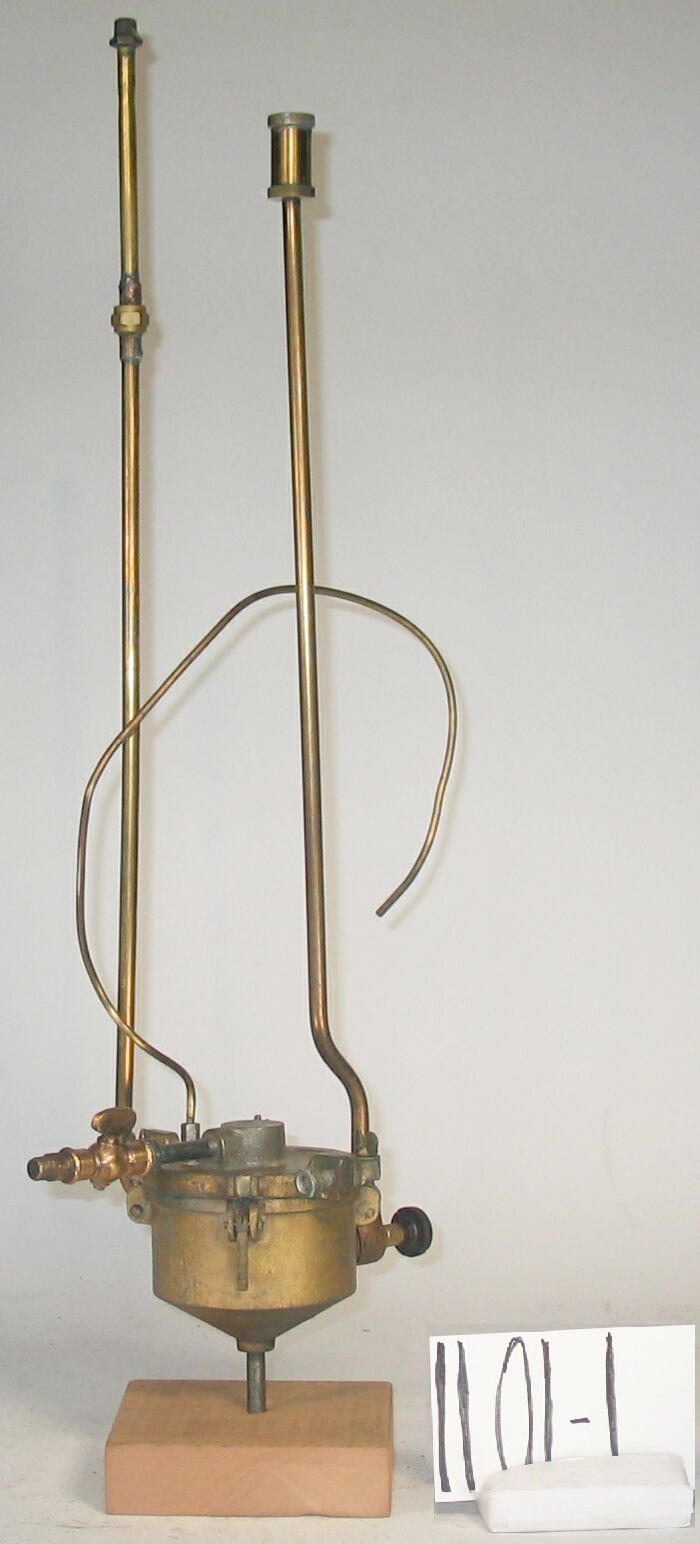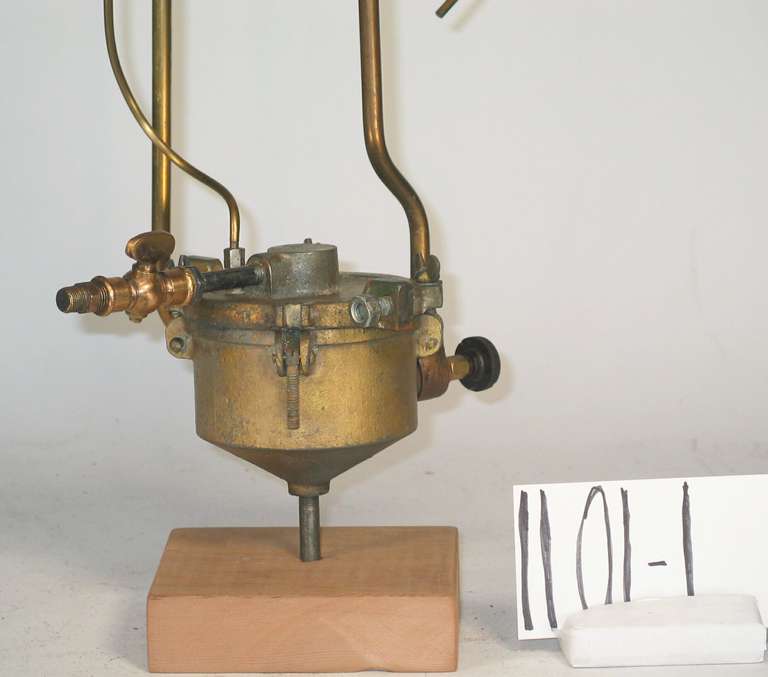11.01-1: Colman 1922 Vaporizing Oil Burner

| HHCC Accession No. 2006.154 | HHCC Classification Code: 11.01-1 |
|---|
Description:
A non motorized, vaporizing oil burner for the Canadian home, employing natural gravity feed, with fuel reservoir and brass float actuated fuel oil metering device, brass valving and tubing, engineered by a widely acknowledged pioneer of oil heating equipment in Canada, Coleman Lamp and Stove Co. Ltd. Toronto, Circa 1922
Group:
11.01 Vaporizing Oil Burning Equipment and Systems - Burners
Make:
Colman
Manufacturer:
Coleman Lamp and Stove Co. Ltd. Toronto
Model:
unknown
Serial No.:
Size:
6 x 6 x 32inch h [mounted on pedestal]
Weight:
8 lbs.
Circa:
1922
Rating:
Exhibit, education, and research quality, illustrating the engineering and design of early, non motorized, gravity feed, vapourizing oil burners for the Canadian home, by a widely acknowledged leader in the Canadian field, the Colman Lamp and Stove Company of Toronto.
Patent Date/Number:
Provenance:
From York County (York Region) Ontario, once a rich agricultural hinterlands, attracting early settlement in the last years of the 18th century. Located on the north slopes of the Oak Ridges Moraine, within 20 miles of Toronto, the County would also attract early ex-urban development, to be come a wealthy market place for the emerging household and consumer technologies of the early and mid 20th century.
This artifact was discovered in the 1950’s in the used stock of T. H. Oliver, Refrigeration and Electric Sales and Service, Aurora, Ontario, an early worker in the field of agricultural, industrial and consumer technology.
It was used in York County, within a day trip north of Toronto. The county towns were settled early by many with acquired urban tastes, as well as the means to enjoy whatever comforts of the day that new 20th century heating technology could provide.
Type and Design:
Non motorized, Vaporizing oil burner, Natural gravity feed, Fuel reservoir Brass float metering device Brass valves and tubing
Construction:
Material:
Special Features:
Accessories:
Capacities:
Performance Characteristics:
Operation:
Control and Regulation:
Targeted Market Segment:
Consumer Acceptance:
Merchandising:
Market Price:
Technological Significance:
They were the early years of the 20th century and “the machine” had not yet arrived in the basements of Canadian homes. Electrification, a prerequisite on which the electric motor depended was for many, still years away. Oil heating, as an alternative to solid fuels, wood and coal, must depend on less sophisticated technologies. From the vantage point of the early 21st century, the evolution of oil fired, automatic home heating equipment would be seen as generally advancing in four broad waves, each of which would take place over a considerable period of time, each producing many variations of the genre: Vaporizing, non-motorized and non-electrified, technology [see Group 11.01 artifacts, no. 11.01-1] Elemental, motorized, platform mounted technology with peripheral piping and valving components [see Group 12.01, artifact no 12.01-1, and pump assembly 12.06-1] Compacted motorized technology with inherent, peripheral component parts engineered into the pump assembly [see pump assembly Group 12.06, artifact, and 12.06-2] Functionally integrated, motorized technology, beyond being compacted, a number of functions would be smoothly integrated into a single pump assembly, including piping and valving [see Group 12.01, artifact 12.01-2 and pump assembly 12.06-2] This apparatus clearly stands as an example of the first wave, vaporizing, non-motorized and non-electrified, technology This simple and elegant fuel flow management system was designed with great inventiveness to use the natural force of gravity flow, without reliance on motive power. It uses a 36gr. float, hand crafted out of brass sheet stock, to meter oil into a combustion chamber [not included], where it is ignited by hand, vaporized and burned. Te apparatus is simply and beautifully executed using the materials and the manufacturing processes of the period in cast iron and brass.
Industrial Significance:
While systems for automatic fuel feed had been attempted using solid and pulverized fuels [wood and coal], their practical application for household would depend on the availability of a reliable source of clean-burning liquid or gaseous fuels. The casting and hand machining of brass petcocks and fittings demonstrate an unusual commitment to craftsmanship, which would soon not be so evident with the progressive introduction of mass production, automated manufacturing methods. The Ontario oil fields of Lambton County, although short lived, and those of Pennsylvania were among the first in the world to be commercially developed by 1860. They provided an early incentive for the Canadian, automatic oil heating industry, as represented here by Colman.
This equipment was developed and manufactured in the first decade of the 20th century by the Coleman Lamp and Stove Co. Ltd. Toronto, a pre-eminent contributor to the development of HVACR, technology during its embryonic years in Canada.
Socio-economic Significance:
Socio-cultural Significance:
Donor:
G. Leslie Oliver, The T. H. Oliver HVACR Collection
HHCC Storage Location:
Tracking:
Bibliographic References:
Notes:
Related Reports:
CMX02 and CMX04 Calalogue item H1



